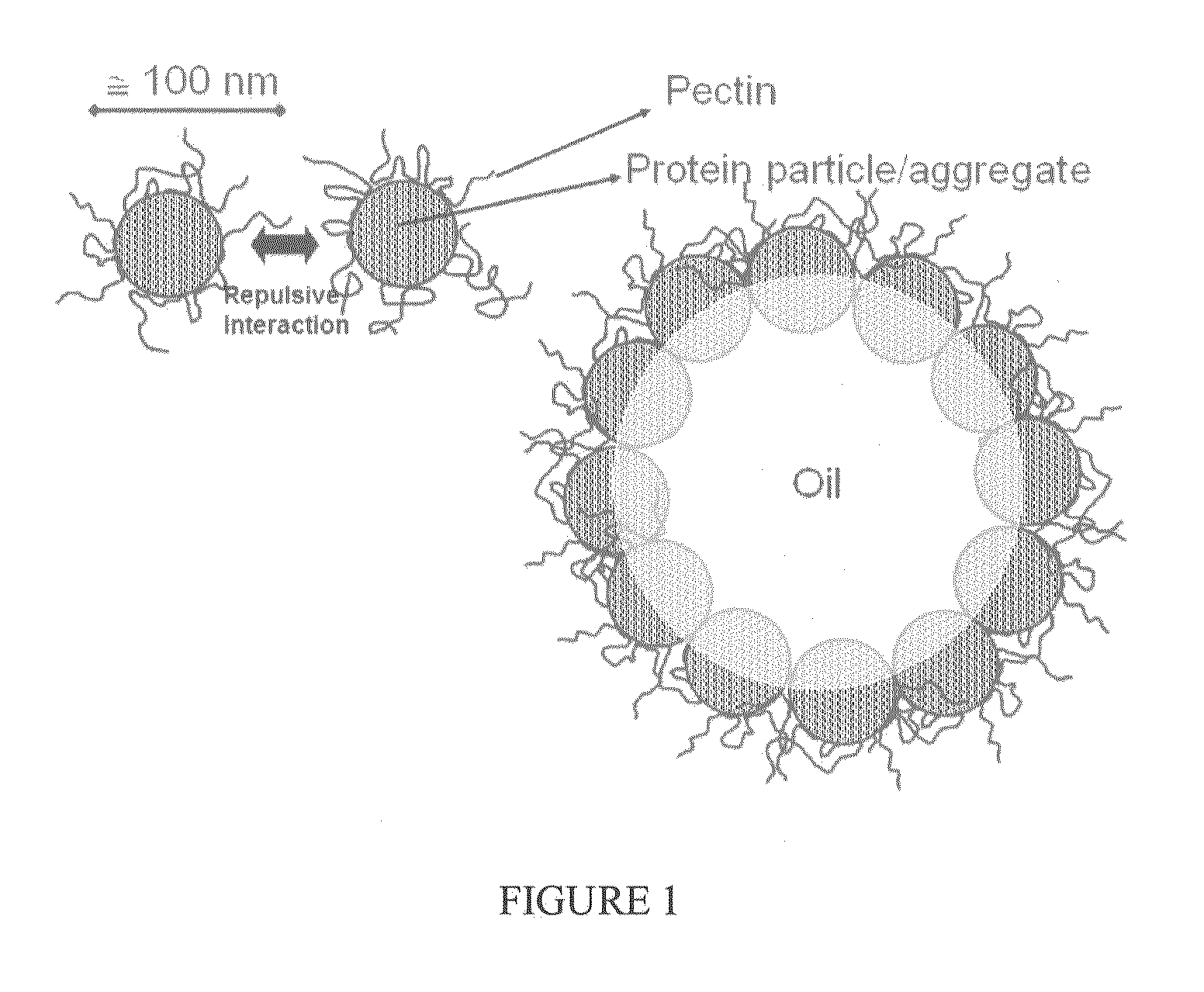Acidic Aqueous Product Comprising Oil-Containing Microcapsules and Method for the Manufacture Thereof
a technology of hydrophobic substances and microcapsules, which is applied in the field of hydrophobic substances protecting hydrophobic substances in acidic aqueous systems, can solve the problems of not providing extended protection against hydrolysis and oxidation, not having a physical or taste-stable, and not having a commercially available fish oil that has proven to be adequately stable in all food contexts, so as to reduce or eliminate the
- Summary
- Abstract
- Description
- Claims
- Application Information
AI Technical Summary
Benefits of technology
Problems solved by technology
Method used
Image
Examples
example 1
Preparation of a Beverage Containing an Aqueous Dispersion of Microcapsules Containing Fish Oil
[0060]An aqueous dispersion of microcapsules in accordance with one exemplary embodiment of the disclosure was prepared using the following method.
[0061]90 g of whey protein isolate (WPI) was dissolved in 1000 g water. The aqueous solution was then subjected stirring using a magnetic stirrer for 2 hours. The aqueous solution was split into two separate solutions (A & B).
[0062]Solution A was kept at 68.6° C. for 120 min and then cooled to room temperature. After heating, the solution contained aggregates of partly unfolded whey protein molecules. The diameter of the aggregates was between 10 and 80 nm, determined by dynamic light scattering. Further, the solution was transparent and non-turbid.
[0063]Solution B was maintained at room temperature and was not heated.
[0064]An emulsion was prepared comprising 220 g of Solution A, 580 g water and 200 g fish oil by high pressure homogenisation (80...
example 2
Preparation of a Beverage Containing an Aqueous Dispersion of Microcapsules Containing Fish Oil
[0069]An aqueous solution having an aqueous dispersion of microcapsules in accordance with another exemplary embodiment of the disclosure was prepared using the following method.
[0070]60 g of ovalbumine (Sigma grade III) was dissolved in 1000 g water. The aqueous solution was then subjected to stirring using a magnetic stirrer for 2 hours. The aqueous solution was split into two separate solutions (A & B).
[0071]Solution A was kept at 80° C. for 30 min and then cooled to room temperature. After heating, the solution contained aggregates of partly unfolded whey protein molecules. The diameter of the aggregates was between 10 and 80 nm, determined by dynamic light scattering. Further, the solution was transparent and non-turbid.
[0072]Solution B was maintained at room temperature and was not heated.
[0073]An emulsion was prepared comprising 330 g of Solution A, 470 g water and 200 g fish oil by...
example 3
Preparation of a Beverage Containing Fish Oil
[0078]An aqueous solution having an aqueous dispersion of microcapsules in accordance with another exemplary embodiment of the disclosure was prepared using the following method.
[0079]An aqueous dispersion of microcapsules in accordance with one exemplary embodiment of the disclosures was prepared using the following method.
[0080]90 g of whey protein isolate (WPI) was dissolved in 1000 g water. The aqueous solution was then subjected to stirring using a magnetic stirrer for 2 hours. The aqueous solution was split into two separate solutions (A & B).
[0081]Solution A was kept at 68.6° C. for 120 min and then cooled to room temperature. After heating, the solution contained aggregates of partly unfolded whey protein molecules. The diameter of the aggregates was between 10 and 80 nm, determined by dynamic light scattering. Further, the solution was transparent and non-turbid.
[0082]Solution B was maintained at room temperature and was not heat...
PUM
| Property | Measurement | Unit |
|---|---|---|
| wt. % | aaaaa | aaaaa |
| diameter | aaaaa | aaaaa |
| diameter | aaaaa | aaaaa |
Abstract
Description
Claims
Application Information
 Login to View More
Login to View More - R&D
- Intellectual Property
- Life Sciences
- Materials
- Tech Scout
- Unparalleled Data Quality
- Higher Quality Content
- 60% Fewer Hallucinations
Browse by: Latest US Patents, China's latest patents, Technical Efficacy Thesaurus, Application Domain, Technology Topic, Popular Technical Reports.
© 2025 PatSnap. All rights reserved.Legal|Privacy policy|Modern Slavery Act Transparency Statement|Sitemap|About US| Contact US: help@patsnap.com



